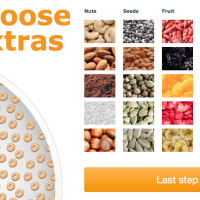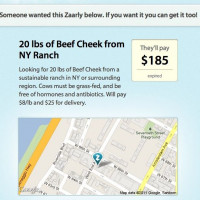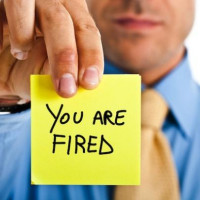At Thumbtack, we make food a priority. It’s amazing what eating does to bring people together. Our team feels like a big family, and this is in large part due to the fact that we share most of our meals: four days a week we eat lunch together around a big table in the center of the office, and once a week we all sit down for a big family-style dinner.
Often startups try to attract talented teammates by offering benefits like ping-pong tables, video games, or gym memberships. While those things are valuable, a culture of good food is an order of magnitude more important. Sharing meals around quality food builds an environment that encourages collaboration and celebrates excellence. The team is excited to come to work because they value and respect the full work environment. We believe every company can benefit from a food-centric culture.
Many of the ideas we have about food are based on the work of UC Berkeley professor and food writer Michael Pollan. His book Food Rules documents some interesting, if old-school, ways to think about food. He avoids writing about specific diets or nutritional fads. Before nutritional scientists started writing about cholesterol and calories, people used different guidelines to decide what and how to eat.
At the risk of sounding too Bay Area, these older “rules” can lead to more holistic concepts of meals, nourishment, and health. Rules come in the form of axioms and old wives’ tales: “better to pay the grocer than the doctor,” “eat your colors”, or “the whiter the bread the sooner you’ll be dead.” The new edition, released late last year, features some great illustrations by Maira Kalman and inspired much of this blog post.
With that, we’d like to present the food rules we’ve come to adopt at.
Rule #1 – Eat lunch together around a table.
Eating lunch together is the single most important culture-building activity we do. This rule has three distinct and equally valuable parts.
a) Eat lunch. At a basic level, food is fuel. Your team needs to eat so they have raw energy to make awesome things.
b) Together. A team that eats together learns, connects, develops friendships, and collaborates more. Joel Spolsky writes about meals at Fog Creek:
The importance of eating together with your co-workers is not negotiable, to me. It’s too important to be left to chance. That’s why we eat together at long tables, not a bunch of little round tables. That’s why when new people start work at the company, they’re not allowed to sit off by themselves in a corner. When we have visitors, they eat together with everyone else.
c) Around a table. This is also Pollan’s rule #58:
No, a desk is not a table. If we eat while we’re working, or while watching TV or driving, we eat mindlessly — and as a result eat a lot more than we would if we were eating at a table, paying attention to what we’re doing. This phenomenon can be tested (and put to good use): Place a child in front of a television set and place a bowl of fresh vegetables in front of him or her. The child will eat everything in the bowl, often even vegetables that he or she doesn’t ordinarily touch, without noticing what’s going on. Which suggests an exception to the rule: When eating somewhere other than at a table, stick to fruits and vegetables.
Rule #2 – Have a weekly all-hands dinner.
We’ve tried other nights, but we really like Wednesday nights for dinner. People tend not to have conflicting evening plans on Wednesdays, and the midweek perk of a delicious dinner helps break the hump-day doldrums.
At dinner, crack some beers and open a bottle of wine. Encourage your team to relax, stop working for a little while, and get to know each other even better. Celebrate what you’ve accomplished that week. Conversation inevitably comes back to the work you’re all doing; don’t worry when that happens, as you’ll have amazing ideas late in the evenings that (sometimes) turn out to be worthwhile.
After some wine, your engineers might try to argue that the Ballmer Peak is a real thing. You should humor them, but under no circumstance should you let them hit that “deploy” button.
Rule #3 – Hire a chef.
 We mean it. Get an office with a big kitchen where your chef can work, and buy all the kitchen gadgets, pots, and pans that your chef wants. Make your chef happy and you will receive incredible food. This will become a point of pride for your company. Our chef Thea was trained at Le Cordon Bleu and has been part of the team for almost three years. You’ll be so happy with your chef, you’ll write blog posts about how great it is.
We mean it. Get an office with a big kitchen where your chef can work, and buy all the kitchen gadgets, pots, and pans that your chef wants. Make your chef happy and you will receive incredible food. This will become a point of pride for your company. Our chef Thea was trained at Le Cordon Bleu and has been part of the team for almost three years. You’ll be so happy with your chef, you’ll write blog posts about how great it is.
If you can’t hire a chef, you should hire a caterer to provide regular, healthy meals. We’ve had good luck with ZeroCater, and it’s likely a good option if your office is in Silicon Valley. If it’s not, Thumbtack can help you find a caterer no matter where you run your business.
If you think you can’t afford it: think hard about how much efficiency you’re losing by not facilitating interaction in your workplace. When your team members go out for lunch, they’re distracted and have to pay their own money and think about what to order and how much to pay. Spolsky writes that it’s a manager’s job to take away all the pains of everyday life so engineers can focus on what they’re good at: engineering. Take away the hassle of finding food.
Rule #4 – Invite guests.
 Having awesome meals at your office means people will want to visit you. This is a great way to network, grow awareness about your company, and learn from all sorts of people you wouldn’t know otherwise. If you’re trying to recruit, lunch is a great way to entice new candidates and have them meet your team without the need for formal interviews. It’s also a great excuse to have people over who might not yet know they want to work for you.
Having awesome meals at your office means people will want to visit you. This is a great way to network, grow awareness about your company, and learn from all sorts of people you wouldn’t know otherwise. If you’re trying to recruit, lunch is a great way to entice new candidates and have them meet your team without the need for formal interviews. It’s also a great excuse to have people over who might not yet know they want to work for you.
One of my colleagues at Thumbtack makes it a priority to invite someone new for lunch every day of the week: this always brings something unique to the conversation and we always end up learning something we didn’t know. We make a point to invite our investors to lunch so they can get to know the team and provide feedback on the business. We have had the occasional celebrity guest to mix things up. I can’t divulge them all, but my personal favorite was Kevin Kelly.
Rule #5 – Don’t buy vending machines.
Vending machines are the easy answer for providing food for your employees. But the things that make vending machines good also makes them bad. It’s great that packaged food has a long shelf-life, but it’s also indicative of food that’s packed with preservatives and lacking actual nutrients, not to mention flavor. This kind of food encourages your team to eat alone, at their desks, any time of day. Pollan’s rule is “Don’t eat anything that won’t eventually rot” and “If it came from a plant, eat it; if it was made in a plant, don’t.”
But don’t think this means you should shy away from decadent food. Pollan also writes, “eat all the junk food you want as long as you cook it for yourself.” Thumbtack often indulges in fried chicken, juicy steak dinners, bread puddings, and chocolate tortes.
Rule #6 – Provide sane breakfasts.
“Don’t eat breakfast cereals the change the color of the milk” (food rule #36). A hearty breakfast has so many benefits: at a basic level it provides fuel for the morning’s work. Breakfast also prevents metabolic highs and lows that can—let’s be honest—really affect the mood and productivity of your team. Let’s also be honest and admit that your engineers probably won’t be starting work until noon, and breakfast may not be the most important meal of their day. All the more reason to get lunch right, and meanwhile make sure there’s still a good breakfast for all those marketing and business development folks who tend to come in on the early side.
Rule #7 – Coffee, tea, and espresso are good.
Caffeine is clearly an aid to concentration, inspiration, and productivity. You might try to argue against this, but the reality is that your colleagues will be chugging the stuff and you should learn to understand them.
At Thumbtack, we buy the best beans from local roasters like Blue Bottle, Sightglass, or Four Barrel. We purchased a Nespresso machine that instantly brews delicious single-serving espressos or Americanos. Our in-house tea drinkers place a weekly order for green tea. While we also have a few Cokes in the fridge, but we intentionally don’t make soda a priority.
Rule #8 – Eat food, not too much, mostly plants.
 This rule is taken straight from Michael Pollan’s classic book Omnivore’s Dilemma. “Eat foods, not nutrients,” Pollan writes. “Stay out of the middle of the supermarket.” Thumbtack’s chef makes all our meals from scratch, starting with fresh, seasonal, and often local ingredients. She works hard to build balanced meals that would make the food pyramid jealous. We stay full, stay healthy, and stay at the office.
This rule is taken straight from Michael Pollan’s classic book Omnivore’s Dilemma. “Eat foods, not nutrients,” Pollan writes. “Stay out of the middle of the supermarket.” Thumbtack’s chef makes all our meals from scratch, starting with fresh, seasonal, and often local ingredients. She works hard to build balanced meals that would make the food pyramid jealous. We stay full, stay healthy, and stay at the office.
And really, eating good, real, fresh food is just better for you and your team any way you look at it. Your doctor will be happy. Your health insurance premium will be happy. You will be happy.
This point is a really big deal for Pollan. “Don’t eat anything your grandmother wouldn’t recognize as food.” “Don’t eat anything with more than five ingredients, or ingredients you can’t pronounce.” There are many foods we eat at Thumbtack that can be difficult to pronounce—bo ssam, mee goreng, cioppino—but they are all made fresh that day.
Conclusion
We think a good culture of food can be the #1 driver of company culture. Work hard, eat well. Everything else is just icing on that cake.
Want to stop by and taste some delicious home-cooked meals? Find us on Twitter. We love to meet new people. Our office is near Powell St. Bart in San Francisco.
Also, did I mention we’re hiring? Eat awesome food with us every day! Apply here.
This post originally appeared on Thumbtack.com.






